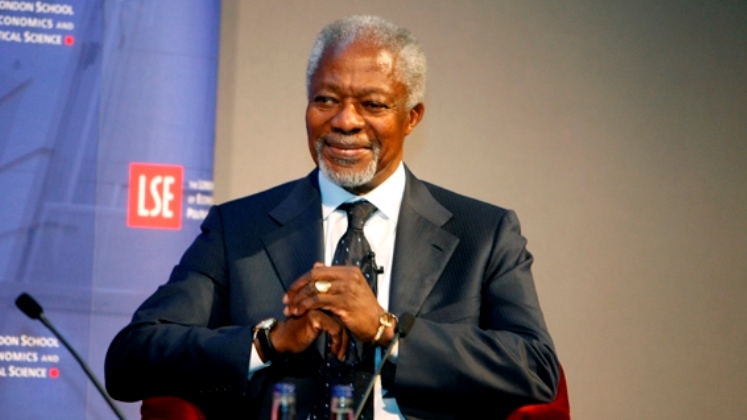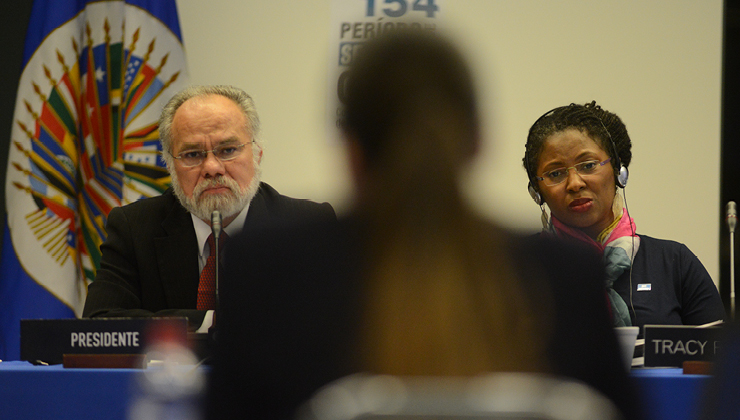On 2018 International Day of Peace, Ruby Weaver, Research Assistant on the Feminist International Law of Peace and Security project, considers the legacy of Kofi Annan.
 Kofi Annan speaking at LSE 4 October 2012 (c) LSE
Kofi Annan speaking at LSE 4 October 2012 (c) LSE
“Most nations have monuments or memorials to war, bronze salutations to heroic battles, archways of triumph. But peace has no parade, no pantheon of victory.” Kofi Annan, Nobel Lecture, Oslo, Norway, 10 December 2001
Since his death in August 2018 Kofi Annan has been revered as a hero for peace. His achievements made headlines as the international community considered his far-reaching influence on international relations and peacemaking. Whilst acknowledging his contributions to global peace and security, it is important to ask critical questions, such as: who exactly did he make peace for? And what lessons can be gained from his successes and failures in the pursuit of creating a more inclusive peace?
Despite widespread praise, reviews of Annan’s tenure are simultaneously mixed. While some commentators critique his passivity, his lack of assertiveness and his internalisation of deeply flawed UN norms, others admire his morality, his position as the “conscience of humanity” and his ability to mediate among the biggest world powers. This commentary stems from the nearly inseparable linkage between Annan’s career and the concept of peace. He was head of UN Peacekeeping, the winner of a Nobel Peace Prize in 2001 and Secretary-General of the UN during ten of the most tumultuous years in international history. While many commentators have focused on his entanglement in power politics, far fewer have assessed his conceptualisation of peace, and his role in defining what peace and peacekeeping meant to the international community.
Annan’s time as the Head of UN Peacekeeping saw two of the worst peacekeeping failures in modern history. The 1994 Rwandan genocide and the 1995 Bosnian massacre both highlighted the failure of the international community’s ability to respond adequately. Many have argued that as a result of these failures, Annan’s approach to protection and humanitarianism shifted. In his 2000 report as Secretary-General, he argued that the sovereignty of nation states should not be prioritised over human rights and that humanitarian intervention was a necessary element in the international community’s responsibility to protect. This humanitarian and interventionist perspective shaped his approach to international relations and led to many commentators arguing that his was a unique approach to peace that represented a crucial shift in international politics. In 2006, Resolution 1674 cementing the Responsibility to Protect (R2P) doctrine was passed. This exemplifies both his interventionist and humanitarian approach, and also his understanding of the gendered dimensions of conflict. Whilst in line with the UN’s women, peace, and security agenda, which recognises the disproportionate and gendered impact of war on women, R2P ascribes a status of victimhood to women in conflict without acknowledging the crucial element of their participation in peace processes. He continued to support high-profile peacekeeping missions, such as in Sierra Leone and East Timor, despite fears of repeating past failures. After his term as UN Secretary-General, he was deployed as a mediator in the most complex of international power struggles and brutal conflicts, such as in Syria and the Rohingya Crisis in Myanmar. That said, the Responsibility to Protect has fallen short in the case of these modern crises.
Annan’s career was one of great power politics, yet his approach and rhetoric professed to put civilians and their rights at the centre. It is this juxtaposition that frames the questions; what did Annan consider to be ‘peace’? And whose ‘peace’ did he work for?
In his first term as Secretary General, the Security Council unanimously passed Resolution 1325, the first of eight resolutions constituting the Women, Peace and Security agenda. Commentators, such as Catherine Powell and Maiya Moncino, argue that the WPS agenda should be considered a success of Annan’s leadership. They argue that without buy-in from senior UN leadership, the resolution would not have passed, and its successful adoption can largely be attributed to Annan’s efforts. Indeed, in his 2002 study on Women, Peace and Security, Annan stated that, “[…] only if women play a full and equal part can we build the foundations for enduring peace — development, good governance, human rights and justice.” Whilst this rhetorical shift was significant, it seemed that both prior to 2000 and during the WPS era, however, Annan’s approach to peacemaking was starkly ‘ungendered’. For example, an independent report on the implementation of 1325 found that while Annan vociferously supported the WPS agenda and utilised gendered rhetoric regarding peacebuilding, both he and his successor failed to mobilise any significant resources to ensure its implementation.
His 2012 appointment as Special Rapporteur to Syria provides an opportunity to explore whether Annan began to truly integrate a WPS approach in his peacebuilding work, or whether his support of gender-mainstreaming and women’s participation in peace processes was limited to discourse rhetoric.
Annan’s six-point peace plan presented to the Syrian authorities in 2012 produced a temporary ceasefire agreement. It was clear, however, that the Assad government had little interest in pursuing a negotiated settlement, and that the international community was reluctant to provide the tangible support necessary to oversee the ceasefire or the political weight needed to incentivise parties to come to the table. The six-point plan seemed to be the pinnacle of his attempt at peace in Syria, yet it failed to mention gender or women, at all. Whilst it called for an “inclusive Syrian-led” political process, there was no integration of WPS language or approaches. The WPS agenda highlights the need to engage women at all levels of peace mediation, negotiation and implementation, suggesting that peace cannot be inclusive without the meaningful participation of women.
In fact, no deliberate and specific channel for women’s participation existed at the track one negotiation level for several years of the conflict. It wasn’t until Stefan De Mistura became the UN Special Envoy to Syria that a ‘Women’s Advisory Board’ was established in 2016. This Board remains limited in its purely ‘advisory’ capacity, but its establishment served to emphasise the lack of prior effort to include women in peacemaking and to take their roles seriously. Annan’s failure to acknowledge how integral women’s meaningful participation is to the durability and sustainability of peace in Syria highlights that he likely considered the WPS agenda as more of a rhetorical tool to be used in the political sphere, rather than a crucial element to long lasting peace.

Annan’s legacy as a peacemaker lives on. His legacy also propels crucial questions with regards to an inclusive peace; one that takes gender into consideration beyond political rhetoric, and towards attaining peace for all. Contemporary conflicts have challenged our notions of peacemaking and peacekeeping; wars are protracted, complex, and inevitably tragic, requiring sustainable and innovative solutions. Annan’s shoes are difficult to fill, but his legacy reminds us that women’s meaningful participation in peacebuilding cannot merely be a ‘bolt-on’ or a rhetorical tool but must be a central part of any sustainable and inclusive peace process.
The Feminist International Law of Peace and Security (#LSEFILPS) project explores questions around the international legal conceptualisation of peace and aims to pave the way for a feminist international law of peace and security. The project is led by Professor Christine Chinkin in the Centre for Women, Peace and Security, and funded by the Arts and Humanities Research Council.
This blog was written with the support of an Arts and Humanities Research Council grant called ‘A Feminist International Law on Peace and Security.
This post was co-edited by Farah AlHaddad and Christina Holland, Research Assistants on the Feminist International Law of Peace and Security project.
Header image credit : United States Mission Geneva (CC BY-ND 4.0)
The views, thoughts and opinions expressed in this blog post are those of the author(s) only, and do not reflect LSE’s or those of the LSE Centre for Women, Peace and Security.





